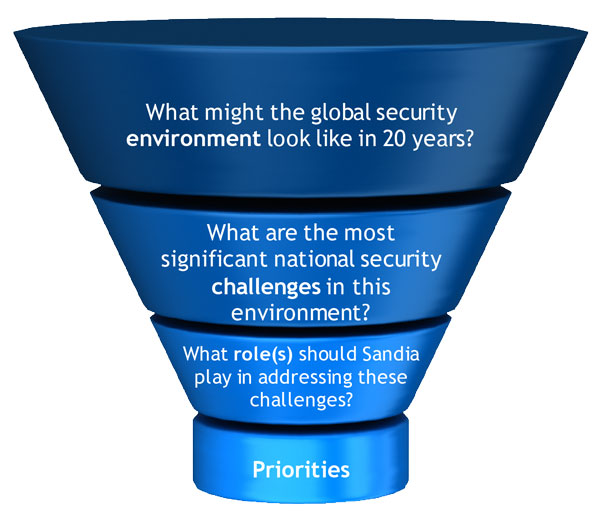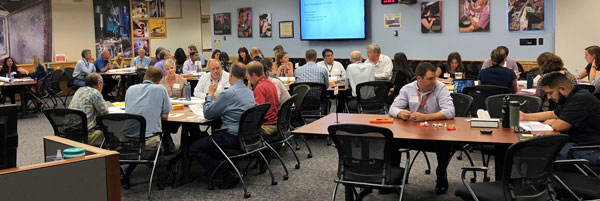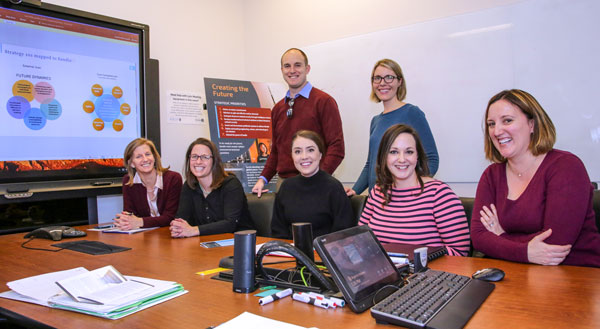
What might the global security environment look like in 20 years?
What are the most significant national security challenges in this environment?
What role should Sandia play in addressing these challenges?
Answers to these questions, examined over a 15-month period by more than 1,000 experts inside and outside the Labs, led to Sandia’s new Creating the Future strategic direction document, and Labs-level strategic priorities.
“Given the pace of global events, we believe such a long-range view is essential to avoid technology surprise and ensure that the U.S. is prepared to meet future threats,” Labs Director Steve Younger said. “Rather than let things happen and respond to them, we have an opportunity to create the future.”
But, just how do you Create the Future?
An individual might draft a list of personal goals, create a vision board or surround herself with like-minded people on a similar path to some future state. An organization might enlist diverse experts in a variety of fields, assess the current landscape and predicted futures and conduct SWOT-like analyses to help determine where to have the most impact and how to cultivate a desired state.
When you’re a world-class national laboratory that develops advanced technologies to ensure global peace the future is incredibly dynamic, shifting with government direction and leadership and global events.
“As a Federally Funded Research and Development Center, we were created to address long-term challenges,” Steve said. “Part of our service to the nation is to scan the horizon for emerging national security issues and articulate the challenges we anticipate for the country.”
Process to progress
Sandia’s strategy development encompassed a broad range of activities, such as research and analysis, environmental scans, workshops, Labs-wide crowdsourcing, surveys and leadership meetings and engagement.
The imagined futures reflected a complex global security environment driven by several key dynamics: technical convergence and individual empowerment; a polycentric world with new actors challenging institutions; climate change and constrained resources; continuing superpower dynamic with emerging frontiers of engagement; and accelerated information diffusion.

Discussions about how to prepare for these dynamics focused on five broad roles for Sandia to play in addressing these challenges: anticipator, technical advisor, technology developer, systems integrator and rapid responder. Variations on the roles can be found within the Labs’ strategic priorities.
Labs-wide teams composed of experts in technical fields, mission support and strategy studied national security topics and presented their findings to executive leadership. Sandia’s leadership team then finalized the topics and language, and developed a set of Labs-level strategic priorities:
- Deliver on today’s commitments.
- Maintain an agile and effective nuclear deterrent.
- Anticipate threats to national security through intelligence science.
- Develop transformational technical solutions to detect threats to national security.
- Invent and demonstrate pathfinder systems to address threats.
- Deploy outstanding engineering, science and technology to our missions.
- Unleash the power of Sandia.
Avoiding another ‘Sputnik moment’
The Labs’ strategic direction document hopes to serve as Sandia’s “North Star.” It’s a living document that provides a framework for decisions needed to bring the purpose statement to life over the next two to three decades.
Steve recently met with each priority team and challenged them to take up to a year to study their threat space and challenges and come back with big ideas that will change the world.
“Start with what problem we are trying to solve, then evaluate the whole spectrum of actions we could take,” he said. “The solution may even seem impossible — well, lots of things used to seem impossible.”
Recognizing strong interdependencies among priorities, Unleash the power of Sandia is partly charged with imagining the ideal institution needed in order to support the others. One example is a collective desire among all priority teams for greater institutional agility, allowing rapid course changes, even if that means failing and trying again.
While many nations around the world are actively working to anticipate and prepare for the future, Sandia leadership believes the Labs must be at the forefront, looking for what can’t be seen. They’re calling for deep thinkers from varied disciplines throughout Sandia, and even external partners, to challenge current paradigms with divergent thinking to uncover what’s beneath.
“The United States has enjoyed technology dominance for a long time,” Steve said. “With rapidly rising budgets and capabilities in other countries, that is changing. And, if we don’t look we won’t be the ones to find the breakthrough. We may not find it even if we look, but we certainly won’t if we don’t try. Another Sputnik moment is coming.”
The recognition that other nations are spending a lot of time and money on discovery is part of what fueled leadership discussions about risk acceptance, and how Sandia might work within its governing parameters to think big. Innovative, forward-leaning people throughout Sandia have taken up this charge.

“Team members have served in addition to their ‘day jobs’ for over a year,” said Elizabeth Roll, senior strategist. “They’ve become subject matter experts on their priority and have helped the rest of us better understand the threat space and opportunities for impact.”
Now what?
The strategic direction document outlines the why and what, intentionally leaving the how to be determined by the priority teams, and any area of Sandia that sees its work aligning with the intent of the priorities. Currently, teams are busy working on priority development and deployment, which will take the planning project well into 2019.
“This is really hard, and it takes time,” Steve said. “I’m asking folks to not focus only on what Sandia does today, but what we need to do in the future in order to tackle a big idea that changes the world. With a 20-year horizon, we can spend a percentage of that time thinking.”
Each priority has an associate labs director as champion, a director lead and a supporting team (in some cases multiple teams, or variations) tasked with overseeing the big ideas that will give the priorities substance and attention over the years, and tracking their progress through familiar methods – management reviews, milestones, etc.
“Implementation is spread throughout Sandia, with no priority existing in a vacuum,” Elizabeth said. “We’ve worked with these groups from the beginning – everyone from ALDs, directors, managers, and staff from every division. We did this with intention, so that the deployment phase would not be a surprise to those charged with making it happen.”
With or without a strategy, Sandia would continue to play its part in the global security environment, delivering exceptional service in the national interest. However, a strategy may help Sandia do more than that, allowing the Labs the freedom, and permission, to think beyond current responsibilities and on to the next big idea.
“There is something out there as important to national security as the Manhattan Project,” Steve said. “We’re the ones to find it.”